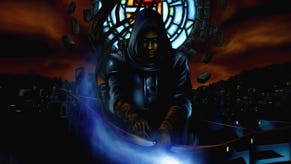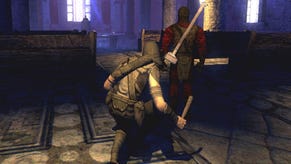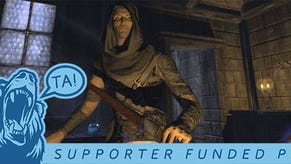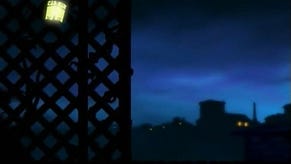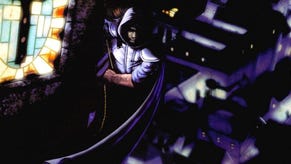The Making Of Thief: Deadly Shadows
[This time we turn our attention to the development of the third Thief game. It's worth noting this is the first making of where the person I interviewed wasn't the effective Project Lead. This leads to a very different interview. I'm speaking to Jordan Thomas, who's got a way with a quote. I've interviewed Jordan a few times before: here's him on the Cradle and here's him on lighting in Bioshock. EDIT: When I was putting the article online, I somehow snipped a whole paragraph and a half when formatting it. It was the bit after the word "Academic", and actually one of the key sections of the whole interview. Excuse? Er... I was deeply hungover. Will that do?]
When Looking Glass shattered, your correspondent, along with the vast majority of Thief’s sizable, fanatic fanbase, got more than a little despondent. Was there any hope for a continuation of the greatest stealth game the world had ever seen? Well, yes, there was, as otherwise we wouldn’t be doing a post-mortem of Thief III and instead continuing to weep hot tears into our foaming mead. The game arrived in the hands of Ion Storm Austin, fresh from their success in making the original Deus Ex. With a new team, mixing veterans of Looking Glass and new staff, they faced the challenge of matching their forefathers.
In many ways they did. Thief: Deadly Shadows isn’t a perfect game – but then neither were any of the Thief games. But the journey from concept to completion was clearly a difficult one, with some noticeable scars on the final game. Jordan Thomas was second to last man into the Design Team. He was there for the long journey from November 2001 until the game actually shipped, ending up as Lead Designer. What were things like when he arrived? “It was probably pre-alpha,” he recalls, “Very rough. You could move Garrett around. He had some of his basic abilities, like you could mantle on things. Technology was nowhere near where it needed to be. We had a guy who was working on a real-time lighting renderer. And that’s Herculean. The fact is, we got it out before Doom, and we were trying to take on some of the same issues: Normal Mapping.”
“Things were going pretty well at that point,” he continues, “We were all really idealistic at that point, even though they’d been through some level building hardships. Because Randy [Smith, Project Lead – Ed] was a phenomenal design lead, and at that moment he was acting like a Design Lead in every sense of the word. We learned so much from him, very quickly. When things started to solidify, with a given space starting to feel great and the lighting technology came online, our enthusiasm was definitely at an all time high. But it was a rough project, and we had a lot of trials ahead from when I was hired.”
Many of the difficulties centred around technology. “If you’re going to be a middle-ware company – if you’re going to be a content company, and say your strength is to come up with game systems and content that are groundbreaking… don’t also attempt to be a technology company,” Jordan argues, “We decided to write our own renderer. The company had no experience with that. They’d barely gotten the Unreal Tournament technology to be subject to their whims for Deus Ex… and when that renderer finally did come online, it was somewhat nightmarish. Not the fault of the guy who wrote it, just that it would have needed another year of hashing out issues before it was really ready. If there was one thing that was the Achilles heel of both Invisible War and Deadly Shadows it was the technology. It was hard for us to use, and we could never really get the performance up to what it needed to be for retail. And we fought it the whole way there.”
In terms of other problems, it’s perhaps telling that there was a time that Ion Storm were discussing a change to the name “Manifesto Games”. “There were some radical departures from traditional structured business at Ion Storm, which often lead us in a direction which people like to call “Organic” but really meant that mostly you were… well, self-congratulating while the game wasn’t making as much progress as it needed to. It was so academic. Amazing as the design culture there was, it sometimes felt more like a school.”
In other words, a over-emphasis of theory over practice. ”To the credit of the guys who were the progenitors, the philosophy of design that you would learn there was very sound, and you could apply it all the time,” Jordan elaborates, “But I often got the feeling that we spent so much time discussing a given… well, for example, we’d say “This is exactly how the game should work. This is how the core game should flow”. And we’d discuss it at great length, take down notes and finally implement… but at that time there wasn’t enough time really to iterate upon it. A much more sound process, in an Art-for-hire industry, is to prototype earlier. Make something you can get your hands on, and then iterate rapidly on that and allow to evolve into your game, rather than believe you can really put your game down on paper. I don’t believe that. I believe the best games are the ones that they could play and tune as early as pre-alpha”
Not that their formalist rigour didn’t mean they were pushing consciously in a progressive direction, much of which is evident in the game’s many high points. “On some very basic level, we were trying to do the right thing with game design,” Jordan notes, “We were pushing the right boundaries. The notion of simulation and free-play spaces, with prone to emergent, systemic design… that absolutely is the wave of the future. People are going to start demanding that the world behave as if it’s a collection of inter-reflection behaviours, rather than “Hey – look! These are our deterministic rules for how things works. If you don’t use the chainsaw on the desk, which we’ve told to respond to the desk, it’ll never, ever function”. But at this stage, we were sort of on the frontier and kind of stumbled. But we paved the way.”
“If you want to look at a good example – and the Ubi guys will admit this freely – the Splinter Cell series owes a lot to Looking Glass and Ion Storm games,” Jordan adds, “That’s a great example of what you can do if you take that same sort of design philosophy, at its core, and apply it to a much better positioned franchise with a more mass-market core fantasy”. Which does make you wonder how they dealt with the obvious difficulties and compromises of co-development, with Deadly Shadows appearing simultaneously on PC and Xbox.
“As PC intelligentsia traditional systemic-design nerds, which is what we were, we found that the technical restraints of a console were relatively challenging,” Jordan answers, “On top of that, there was “Hey – how easy does this game have to be? At what level are we patronising?” For example, console gamers in general prefer a little more clear direction while PC gamers tend to prefer to be thrown into a playground and told “Hey – Go! Find the other side”. We constantly tried to find that sweet spot. I feel that Deadly Shadows is mostly mainly a PC game on the console… though you can’t truly please the hardcore PC fans with any form of compromise. From the very beginning, we tried hard to strike a balance so the more moderate PC fan and the more moderate console fan – the console player who doesn’t need crazy amounts of direction – would have a good time playing the game. It was definitely challenging. I think all of them have become better console developers having come through it, but it was a long road”.
Any particular lessons which others would be wise to steal from the Thief designers? “Make intelligent use of what technology you choose to undertake and prototype your gameplay experience very early,” Jordan argues, “Don’t try and front load the process with too much theory, essentially, and get it into practice. Make it feel good in your hands, because that’s what we’re doing. We’re making interactive experience, not narrative.”
Note that despite the lacklustre sales of Deadly Shadows, it isn't necessarily the last we’ll ever see of Garrett. Maybe it just needs to be tailored to the needs of its more limited audience. ”I believe honestly that, in the long term, Thief will be better off as episodic content,” Jordan theorises, “Smaller release portions for a smaller, but very regular, audience. I’d love to see the series continue in that vein, but that’s very much up to the people who now own it”. This actually puts Thief:DS in the tradition of the Thief games. Thief, while not being the sales disaster as it’s occasionally painted, certainly never reached the mass audience, focusing on a real a real cult appeal. “They had exotic interests, and were looking for something new in terms of fiction as well as play experience,” Jordan describes Thief's players, “Thief absolutely made a huge splash among that audience… but never got particularly larger than that. The console people, the guys who buy Splinter Cell, aren’t really interested in playing a Thief in a Medieval city. And that’s sad.”





